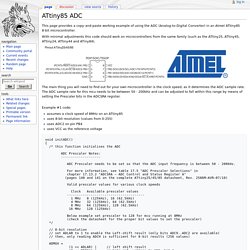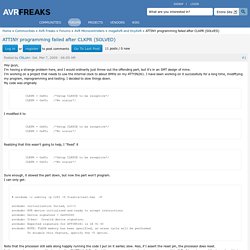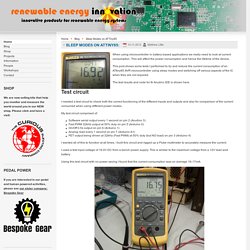

Tout ce que vous pourriez vous demander sur la consommation d'une puce ATmega328p (puce d'Arduino) - Robot Maker. Consommation d'un Arduino, et optimisation d'un montage à base de ATmega328PJe vous propose ici un résumé d'un excellent article que j'ai lu sur le net.

Je tiens avant tout à dire que tout ce que je vais présenter ici provient du travail de Nick Gammon, sur le lien ci dessous :Sur cette page de Nick Gammon, se trouve un post d'immense qualité sur la consommation des ATmega328P, et les moyens d'optimiser celle ci.Si vous comprenez l'anglais, allez plutôt lire l'original, et au pire gardez le lien vers ce résumé pour les tables, et formules L'auteur y mène une investigation poussée sur ce que consomme un Ardruino, puis surtout un ATmega328P sur une breadboard. Bien sur, le Arduino consomme plus que la version breadboard. Cano64/ArduinoSystemStatus: SystemStatus is Arduino library to get information about VCC voltage, Free RAM etc... Réduire la consommation d'un AVR / OS-005 / Open Silicium / Connect - Edition Diamond. Qu'il soit alimenté par panneau solaire ou par piles, un montage autonome nécessite une faible consommation. Cela tombe bien car les AVR sont capables de nous impressionner dans ce domaine.
Voyons ensemble comment... 1. Introduction 1.1. Dès que l'on veut créer des montages autonomes, la consommation devient très vite un facteur limitant. ATtiny85 ADC - wikipost. This page provides a copy-and-paste working example of using the ADC (Analog-to-Digital Converter) in an Atmel ATtiny85 8-bit microcontroller.

With minimal adjustments this code should work on microcontrollers from the same family (such as the ATtiny25, ATtiny45, ATtiny24, ATtiny44 and ATiny84). The main thing you will need to find out for your own microcontroller is the clock speed, as it determines the ADC sample rate. The ADC sample rate for this mcu needs to be between 50 - 200kHz and can be adjusted to fall within this range by means of setting the Prescaler bits in the ADCSRA register. H2OhNo! Favorited Favorite 1 The firmware behind H2OhNo!

Is simple in theory and long in practice. We need to establish that when water is present then sound the alarm. Battery life Calculator. Gammon Forum : Electronics : Microprocessors : Power saving techniques for microprocessors. Summary In this thread I show various power-saving techniques for the Atmega328P processor.

They include sleep modes, use of power-reduction registers, and other techniques. Applying all of them can result in a current draw as low as approximately 100 nano-amps (100 nA), well below the self-discharge rate of most batteries. Proof from the datasheet for the Atmega328P (page 405 of my copy): That is 100 nA at at 25°C running at 3v. These techniques would be useful for battery-powered devices where the full power of the processor was only required intermittently, for example a TV remote, calculator, doorbell, or some sort of environmental monitor where you only needed to check things from time to time. ATTINY programming failed after CLKPR (SOLVED) Level: Rookie Joined: Sun.

Feb 17, 2008 Posted by CNLohr: Sat. Réduire la consommation d'un AVR / OS-005 / Open Silicium / Connect - Edition Diamond. ATTiny85 Wake from Sleep on Pin State Change Code Example. I spent an inordinate amount of time trying to figure out how put my ATTiny85 to sleep and then wake it up when the state of a pin changes.

So I’ll document my test code in case anyone else goes searching for a simple example. The reference I ended up using is: Unfortunately, even after reading through the forum thread the final working code was evidently never posted. However, there was enough here for me to figure out the problem and get it running. The following code is very simple. ATtiny85 ADC - wikipost. 3 Minute Game Timer, a Deep Sleeping ATtiny85 Digispark: 7 Steps. For those who plan to cut off the battery supply for long term storage, via switch or battery removal, this is more than enough power savings.

If this is not the case and you are proficient with fine soldering and caring for surface mount components, then you may want to take these additional measures. To further reduce ambient current drain, I also cut the trace to the resister R3 used to pull up the PB3 signal (for USB download communications) Digispark schematic. This is rather problematic, as it has to be effectively undone in order to allow download via USB. Furthermore it seems that the loaded logic which runs on power-up gets stuck if the data line connected to R3 is not pulled up.
Thus, I had to solder in (very carefully and precariously a diode (1N4148) from the '5v' line to the end of R3 I had cut the trace by. Using PB3, for the tilt switch, continued to cause operational and perhaps power management issues, so I stop using it. Exploration des "sleep mode" du attiny85. Le attiny85 est un tout petit microcontrôleur de Atmel, disponible en boitier DIP8.

Il a donc juste 6 GPIO. Il coute moins de 2€. Bref c'est un microcontrôleur assez chouette pour de petits projets, ou en complément pour décharger un microcontrôleur principal. Sleeping Arduino - Part 5 Wake Up Via The Watchdog Timer. OverviewWelcome to the fifth and final part of the "Sleeping Arduino" series, where we will cover how to wake the Arduino from sleep mode using the Watchdog Timer (WDT).

When waking your Arduino from sleep, you could use one of the standard internal timers of an Arduino as I have detailed in Part 4, but if you are looking for the maximum sleep time and/or minimum sleep power consumption, you have the use the WDT;As I have mentioned in this table, the WDT can give us a sleep time of 8 seconds, whereas the 'longest' 8/18bit timer will only give us a sleep time of ~4 seconds.Watchdog Timer (WDT)The Watchdog Timer on the Arduino's microprocessor only has one source to drive it: it's own separate internal 128kHz oscillator (as opposed to the 8/16bit internal timers, which can use either the 16Mhz system clock or an external clock).
The WDT also has a prescaler, which is used to configure the timeout period. Sleep Modes on ATTiny85. When using microcontroller in battery-based applications we really need to look at current consumption.

This will affect the power consumption and hence the lifetime of the device. This post shows some tests I performed to try and reduce the current consumption of an ATtiny85 AVR microcontroller using sleep modes and switching off various aspects of the IC when they are not required. The test results and code for th Arudino IDE is shown here. I needed a test circuit to check both the correct functioning of the different inputs and outputs and also for comparison of the current consumed when using different power modes. Test comparatif de la consommation électrique à vide de diverses cartes Arduino et compatible.
Lightweight Low Power Arduino Library. We have just release the 1st revision of our low power library for Arduino. This is a simple and easy to use library that has the following features: Supports all sleeping mode of ATmega328P: Idle.ADC reduction mode.Power save.Power down.Standby.Extended standby.Selectable sleep duration: 15 ms, 30 ms, 60 ms, 120 ms, 250 ms, 500 ms, 1 s, 2 s, 4 s, 8 s, and forever (wake up using other resources) through on chip 125 kHz Watchdog timer. Using sleeping forever duration, the Watchdog timer module is not in use and will further reduce the current consumption by approximately 4 µA.Option to shutdown Analog to Digital Converter (ADC) module to further reduce current consumption.Option to disable Brownout Detector (BOD) module to further reduce current consumption by approximately 17 µA.
BOD module cannot be disabled through software in idle and ADC noise reduction mode. Tout ce que vous pourriez vous demander sur la consommation d'une puce ATmega328p (puce d'Arduino) - Robot Maker. [Résolu] Alimentation arduino batterie rechargée en solaire. En ce qui concerne la batterie, je ne me fais pas trop de soucis, elle peut parfaitement délivrer quelques ampères. How to Run an Arduino for Years on a Battery - Open Home Automation. If you found this article after doing a search on Google, welcome! On this website you will find plenty of content around DIY home automation using open-source hardware. Enjoy the article! For most of the Arduino tutorials you will find on this website, power is usually not an issue as the Arduino is powered by the USB cable coming from the computer. However, sometimes you want to build systems that are going to be autonomous and powered by a battery. For example, you want to power the wireless motion detector just by using a set of batteries.
The first thing we need is to build our own Arduino system with just the minimal set of components. Gammon Forum : Electronics : Microprocessors : Power saving techniques for microprocessors. Mettre en veille l'arduino pour gagner de l'autonomie.